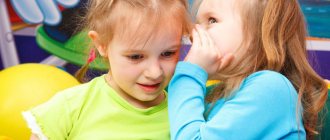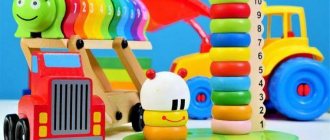Critical periods of speech development
Maria Checheleva
Critical periods of speech development
Critical periods in the development of speech function
Speech function is one of the most important mental functions of a person.
In the process of speech development, higher forms of cognitive activity and the ability to conceptual thinking are formed. The meaning of a word in itself is a generalization and, in connection with this, represents not only a unit of speech, but also a unit of thinking. They are not identical and arise to some extent independently of each other. But in the process of the child’s mental development , a complex, qualitatively new unity arises - verbal thinking , speech-thinking activity .
Mastering the ability to verbally creates the prerequisites for specifically human social contacts, thanks to which the child’s ideas about the surrounding reality are formed and refined, and the forms of its reflection are improved.
A child’s mastery of speech contributes to awareness, planning and regulation of his behavior. Speech communication creates the necessary conditions for the development of various forms of activity and participation in collective work.
Speech disorders to varying degrees (depending on the nature of speech disorders )
negatively affect the entire mental development
affecting his activities and behavior. Severe speech impairments can affect mental development , especially the formation of higher levels of cognitive activity, which is due to the close relationship between speech and thinking and the limited social, in particular speech , contacts, during which the child learns about the surrounding reality.
Speech disorders and limited verbal communication can negatively affect the formation of a child’s personality, cause mental layers, specific features of the emotional-volitional sphere, and contribute to the development of negative character traits (shyness, indecisiveness, isolation, negativism, feelings of inferiority).
All this negatively affects literacy, academic performance in general, and choice of profession.
There are three critical periods in the development of speech :
1 period
occurs in the first two years of a child’s life, when the prerequisites for speech appear and its active formation begins. the cortical speech zones develop most intensively , in particular Broca's area, the critical period which occurs at the age of 14-18 months. Even minor unfavorable factors operating during this period can affect speech development .
2 critical period-
three year old child. At this stage of development , significant changes occur: coherent speech develops , the transition from situational to contextual speech begins, which requires great consistency in the work of the central nervous system with peripheral speech mechanisms and other functions. However, due to their immaturity, some discrepancy may arise in the functioning of the nervous system, endocrine, and vascular systems, which leads to changes in the child’s behavior, manifested in negativism, stubbornness and determines the vulnerability of the speech system . For these reasons stuttering may develop speech development may be delayed . Stuttering can also arise due to age-related unevenness in the maturation of individual parts of the speech functional system and other mental functions.
3 critical period –
age 6-7 years. Associated with the child’s preparation for school and the beginning of education there. Its main feature is that the load on the central nervous system increases. If increased demands are placed on the child at this time, then a kind of disruption of nervous activity occurs, which can cause stuttering.
The named critical periods are predisposing conditions for the occurrence of speech disorders . They can have either independent significance or be combined with other unfavorable factors: genetic, general weakness of the child, dysfunction of the nervous system, etc.
Stages of children's speech development
Knowing the main stages of speech development will help to identify possible speech problems in a child in a timely manner. Despite the fact that there are no strict standards (after all, each child develops at his own individual pace), any deviation from age norms should alert attentive parents and become a signal for timely contact with a speech therapist. It is better to have a specialist refute your concerns than to miss a grace period to correct the violation.
The first year of life is extremely important for a child’s speech development, as the speech areas of the brain are actively maturing. The first year is the pre-speech period, which is the foundation for the further development of speech. It can be conditionally divided into the following stages: first (0 – 3 months) – development of emotional and expressive reactions; the second (3 – 6 months) – the time of appearance of vocal reactions (humming and babbling); third (6 – 10 months) – the beginning of the development of speech understanding and active babbling; fourth (10 months – 1 year) – the time of the appearance of the first words.
First stage (0 – 3 months)
Screaming is the first vocal reaction. The cry of a healthy child is loud and long. By 2–3 months of life, intonations when screaming become varied. For example, the cry of a hungry baby is shrill and persistent, but the cry of discomfort is sluggish and inexpressive. A “revitalization complex” appears - the simplest form of pre-verbal communication with an adult in the form of a smile, general chaotic movements, sounds, and following an adult with one’s gaze. Already at this age it is possible to intensify the child’s development, because With the advent of the revival complex, the child begins to need constant communication. It is necessary to offer the child toys of different shapes and colors, loud sounds, play with him more often, moving toys, cultivating visual concentration and motor grasping actions.
By the way, in order to calm the baby, it is not necessary to resort only to the pacifier, because when he sucks on it, he is completely distracted from the world around him.
Second stage (3 – 6 months)
By the third month or a little earlier, humming appears. Humming – long, quiet melodious sounds: “a-a-a-a”, “gu-u-u”, “a-bm”, “boo”, etc. These sounds are either easy to pronounce or associated with the acts of sucking and swallowing. During the period of rejoicing, an intonation of joy appears. The baby walks when he feels good: he has slept, is dry and well-fed. At 4 months, sound combinations become more complex and new ones appear: “gn-agn”, “rn”, “khn”, etc.
Absolutely all children have babbling. Children all over the world walk the same way: in the speech of the baby you can hear the sounds of all languages. But later the baby will select only those sounds that are characteristic of his native language.
With normal development of a child at 4–5 months, humming smoothly turns into babbling. Babbling is the reproduction of syllable combinations, imitation of the speech of others. The most intensive process of accumulation of babbling sounds occurs after the sixth month. With severe speech disorders, babbling is detected in children at a later age! For the deaf and hard of hearing, the humming fades out. During this period, the mother should happily repeat individual syllables and words after the child, voicing them correctly, helping to find objects corresponding to these words.
Third stage (6 – 10 months)
From 7–8 months to 1 year, few new sounds appear. The child rhythmically repeats “cha-cha-cha...”, “gee-ha-gee...” and other babbling chains many times in a row, honing his pronunciation skills and at the same time listening to himself. So gradually quantity turns into quality. Babbling words appear, which the baby associates with certain persons, objects, and actions. “Bi-bi” - points to the car, “top” - walks, “ma-ma” - addresses mom, etc. Babbling words consist of those sounds that are close in sound to the sounds of the native language (as opposed to the sounds of humming). Healthy children have emotionally expressive speech. In the process of communicating with adults, the child tries to imitate the intonation, tempo, rhythm of spoken speech, and maintain the general contour of the word.
During this period, an understanding of the speech of others is formed. Already at 7–8 months, children begin to respond adequately to words and phrases that are accompanied by gestures and facial expressions. The child turns his head in response to the questions “Where is daddy?” Woman?". Reacts to his name. Knows the usual location of household items (clocks, cribs...) if they have been shown and named before. In other words, the relationship between the sound image of the word and the object begins to develop. Complete misunderstanding of the addressed speech is an alarming signal!
Fourth stage (10 months – 1 year)
The first words appear - word-sentences. The same word can express feelings, desires and designate an object. “Mom” is an appeal, a request, and a complaint. The first words consist of paired identical (much more often) and unequal syllables: “pa-pa”, “di-di”, “bi-ka”, etc. In this case, one syllable is distinguished by its volume and duration. This is how the emphasis is laid. Speech activity at this age is situational and depends on the adult’s emotional participation in communication. At 1 year old, a healthy baby speaks 8-10 words like “kiss-kiss”, “mu”, “yum-yum”.
From 1 year to 3 years (pre-school age), active speech develops as the child begins to walk. With the advent of the ability to move, ideas about the surrounding world quickly expand, speech develops intensively: the baby asks what is called what. In speech, sound distortions are observed, stressed and initial syllables are used, difficult sounds are skipped, and there are permutations of syllables.
By the end of the second year of life, elementary phrasal speech . When communicating with an adult, the baby combines 2-3 words, for example, “give pi” (give me something to drink), “papa bi” (dad left), etc. Gradually, grammatical categories are formed (number, gender, case...).
By the age of 3, the child independently uses the simplest grammatical structures . When communicating with adults or peers, children use simple sentences.
Characteristic of this period is a fairly stable reproduction of the intonation-rhythmic contours of words, for example, “kayable” - ship, “petenka” - cookie, “badyadya” - lipstick.
word creation appears . The child comes up with his own words, but at the same time uses the laws of his native language: “palchatki” - gloves, “kopatka” - spatula, i.e. the baby masters the basic laws of language.
In subsequent years, the child actively increases both the passive vocabulary (speech understanding develops) and the active vocabulary (this is the vocabulary that the child uses in speech). Normally, by the age of 5, he should have developed all aspects of his native speech : vocabulary, grammar, sound pronunciation and phonemic perception. The child must have a fairly rich vocabulary, be able to coherently talk about some event in life or retell a fairy tale, story, and do it competently, observing the agreement of words in phrases, word endings, etc. Free speech of five-year-old children, whether retelling what they heard or a story invented by oneself or reflections on something important for the child, includes complex sentences with correctly constructed cause-and-effect relationships. “They gave me a guinea pig because I really wanted my own pet. She will not be able to feed herself, so she needs to be looked after. She squeals loudly when we come home because she is so happy.”
Adults make a significant contribution to the development of speech in children from 3 to 5 years old and their communication skills if they competently, interestedly and, most importantly, constantly communicate with the child, comment and clearly articulate their and his actions, encourage him to tell stories, explain various situations and phenomena.
What is included in the concept of “speech development”?
Parents often understand speech development as a rather narrow area. For example, the active vocabulary of a child of a certain age often seems to adults to be the only criterion for harmonious speech development. Others pay special attention to the purity of pronunciation of sounds. Still others look at the length and complexity of sentences composed after the age of three.
Depending on what adults mean by the concept of “speech development,” their linguistic behavior towards the baby will also differ significantly. Someone insists that the child memorize as many poems as possible, someone tries to “put into his head” as many different concepts and meanings as possible, and someone insists on daily repetition of pure sayings.
However, this concept is too broad to focus on any one component. After all, the ultimate goal of a child’s speech development is to teach him to competently and accurately express his thoughts and describe phenomena. The development of speech is closely related to the formation of verbal thinking, the assimilation of the laws of communication and much more.
To better understand how to help a child not just learn to speak, but to comprehensively develop his speech, one should dwell in more detail on the main stages of its formation.
Periodization according to A. N. Leontiev
A. N. Leontyev identified 4 main stages of speech development in ontogenesis, which begin at birth and cover the school years. A brief description of them is presented below.
Preparatory stage
In the period from birth to one year, the prerequisites are created for mastering the components of the language system. The first vocal reactions are screaming and crying, which contribute to the development of the respiratory, vocal and articulatory departments.
At the age of several weeks, the baby begins to listen to the voices of the people around him and respond to them. By the end of the 1st month, he already calms down when he hears a lullaby. In the first months, a revival complex appears: a smile, motor movements of the limbs in response to the appearance of relatives. A reaction to the intonation of an adult appears.
At 2 months, humming appears, and by 3-4 months the babbling stage begins. From 5 months, the child tries to repeat the articulation of adults. From 6 months, syllables appear in speech. By imitating, the baby masters all the basic elements of the prosodic side of speech.
In the period from 6 months to one year, the child distinguishes certain sound combinations and compares them with objects or actions. Gradually, the baby repeats increasingly complex combinations of sounds after those around him. The end of the period is marked by the appearance of the first words and the activation of the communicative function of speech. At this time, it is very important for parents to create favorable conditions for the child to master the language system.
Developmental stage up to three years
Between one and three years of age, children pay special attention to the articulation of those around them. The child repeats after adults and tries to pronounce increasingly complex words. In his speech, phoneme mixtures, substitutions, and distortions occur due to the correct articulatory patterns that have not been formed due to age.
From one to 1.5 years, children's speech is situational (contextual) in nature. Understanding what a child wants can only be done by taking into account the situation. The baby actively uses non-verbal means of communication. Starting from 1.5 years, speech acquires a more generalizing orientation. He begins to understand adults' instructions. From 2 to 3, there is an active accumulation of vocabulary.
By the beginning of the 3rd year of life, simple grammatical categories are mastered. There is a transition from monosyllabic statements to simple phrases with violated agreement norms. Gradually, the child masters the skill of grammatically connecting words in a sentence. By the age of two, he has almost completely mastered the categories of singular and plural; case endings appear. Speech understanding is ahead of the child's pronunciation capabilities.
Preschool development period
In many children, sound pronunciation is distorted because the articulation organs are not yet ready for complex structures. Improves the skill of self-control over your speech and those around you; phonetic-phonemic processes are formed.
Vocabulary continues to grow, with children using approximately 3,000–4,000 words by ages 4–6. The meaning of words is clarified, but sometimes they are used in a way that does not correspond to their meaning. At the age of 4-5 years, the phenomenon of word creation occurs, during which the formation of a linguistic sense occurs.
Grammatical structure and coherent speech develop. Proposals become more complex and more widespread. At 4 years old, complex sentence structures predominate in children's speech. At the age of 5 years, sentences are composed taking into account the grammatical connections of words. Children's answers are like a short story. Mastery of the monologue form of speech begins; the preschooler can retell short fairy tales without the help of adults.
By the end of the preschool period, correct sound pronunciation, phonetic-phonemic processes and contextual speech are fully formed.
School period
Its duration is from 7 to 17 years. A distinctive feature is the conscious acquisition of speech. The skill of sound analysis and the grammatical rules of the native language are mastered. The main role is given to written speech. The child learns to consciously use acquired speech skills.









